MASTER RESEARCH
Student: Eva Calvo López
Supervisor: Andrew Wright
RESEARCH AND CRITICAL EDITION OF CAPRICCIO DIABOLICO BY MARIO CASTELNUOVO-TEDESCO
Speciality: Classical guitar

Table of contents
- 1.-INTRODUCTION
- 1.1-MOTIVATION
- 1.2-RESEARCH OBJECTIVES
- 1.3-RESEARCH QUESTIONS
- 1.4-METHODOLOGY OF THE RESEARCH
- 2.-RESEARCH DEVELOPMENT
- 2.1-BIOGRAPHICAL NOTES OF THE COMPOSER AND THE DEDICATING PERFORMER
- 2.2-RELATIONSHIP BETWEEN THE MUSICIANS. HISTORICAL AND MUSICAL CONTEXT OF THE PIECE [^10]
- 2.3-BACKGROUND OF THE RESEARCH TOPIC
- 2.4-APPLIED METHODOLOGY AND GENERAL CRITERIA OF SELECTION AND EDITION OF MY VERSION
- 2.5-CRITICAL NOTES
- 2.6-SCORE OF MY CRITICAL EDITION
- 4.-BIBLIOGRAPHY
- 4.1-SCORES
- 4.2-RECORDINGS
- 4.3-BOOKS
- 4.4-RESEARCH WORKS
- 4.5-DIGITAL BIBLIOGRAPHY
- 4.6-DATABASES AND LIBRARY CATALOGUES CONSULTED
1.-INTRODUCTION
1.1-MOTIVATION
As a musician and guitarist, I greatly admire the music of Castelnuovo-Tedesco. Apart from its beauty, it is really interesting and has an unquestionable musical quality. However, there are not many critical editions of his pieces despite being widely performed by today’s classical guitarists.
The motivation for this research began last year when I decided to include the Capriccio diabolico in the repertoire of my last year of master. When choosing the score to be used for its study, I realized the need to write my own version, because the actual documentation was very limited and there were considerable differences between one edition and the other one. This really caught my attention, as Mario Castelnuovo-Tedesco is considered a great composer of the 20th century and his work for guitar is extensive and widely performed. However, having to choose between the manuscript or Andrés Segovia’s version for practicing the piece seemed to me to be a very limited choice. The first option means submitting to the study of an unidiomatic piece with insufficiently guitaristic passages, and requires changes due to the impossibility of its execution in several occasions. The second option is to assume that there are original fragments eliminated and numerous significant changes musically speaking. I would like to exploit my criteria as a performer and guitarist to contribute with a third point of view in the interpretative decisions that have to be taken to solve some passages and conflicts presented in the manuscript, showing my own ideas and decisions.
I consider that the study and reflection of this work, as well as the attached score, will be of great use to any guitarist who wants to perform this incredible piece. The research carried out before writing my edition will be done with great care and dedication in order to offer a material with all the musical choices duly justified, and thus achieve a coherent and valuable result when performing it.
1.2-RESEARCH OBJECTIVES
The main objective of this final thesis is the study and comparison of the two written sources of the Capriccio diabolico and the creation of my own edition, making it a resolute version. In this way, I intend to offer a score that is as neutral and functional as possible after the research work and under my own criteria as a performer and guitarist.
I would also like to develop my interpreting skills by contributing to the piece when necessary. In some moments, what is written in the manuscript is not functional, but from my point of view, Segovia’s proposal is not the best. In those cases I would like to bring my own musical ideas as a guitarist and performer of this piece.
Through the recordings attached to this work, I would also like to demonstrate in practice the differences in the scores. In this way, I hope that the reader of this document will be able to observe the sonority, difficulty and functionality of both. By having to make the recordings playing both options, I believe that I will be able to sink deeper into the piece, understanding both parts. This will also help me to get to know the piece more profoundly and to perform it better.
Finally, insisting on the lack of variety of sources for this piece and taking into account that any guitarist who wants to tackle this work only has either the manuscript of the composer, or the guitarist’s interpretative version; I intend to provide a new intermediate edition between Castelnuovo’s compositional vision and Segovia’s guitaristic vision for those who want to consider a third option.
1.3-RESEARCH QUESTIONS
After carrying out the investigation I would like to answer mainly the following question: What sources and interpretative decisions combine to create an effective performance of Capriccio diabolico? To answer this question, it is first necessary to find an answer to these other sub-questions:
What are the differences between these sources?
Which option is more objective regarding the historical and musical context?
Which option is guitaristic more effective?
How to justify the choice between the different options?
I consider it very necessary for the validity of my interpretation and my score that these questions can be answered and justified in every decision I make.
1.4-METHODOLOGY OF THE RESEARCH
Many different procedures have been carried out in order to complete this master research. First of all, I looked for all the sources, both written and sonorous. Among the written sources I found books - biographies, letters between the composer and the guitarist, books by other authors, etc. - and the scores - manuscript, Segovia’s version and Gillardino’s versio, which is based in the manuscript ingoring Segovia´s corrections. With regard to sonorous, Segovia´s recording was a great source to reproduce and understand his interpretation. Many incredible guitarists have recorded this piece.
One of the most important aspects for me was researching the whole historical context of the piece and the two figures. Everything I discovered about their relationship, their way of seeing life and their individual dedication to music has made me understand many things about this issue, and look at it from a more critical perspective. In the bibliography I have listed the sources I am talking about as well as having quoted them at all the necessary points in this work.
After having the sources and being aware of each and every difference, what has been substantial in completing this work has been the experimentation of the options in practice. Being able to play both what the composer wrote and what Segovia changed has helped me a lot to choose the option that best suited the result I was looking for: effectiveness, objectivity and coherence. In this document I include some clips in which I show both options playing and justify the final choice.
All decisions are duly justified. Each time the scores differed I have taken time to practice both and decide which was more coherent and worked better for the guitar. In many cases I have had to superimpose coherence over effectiveness and vice versa, but no decision has been taken in vain and the reflection has been slow and significant.
Last but not least, for me the centrepiece is the score I have written, as it is the practical effect of all this research and reflection. Moreover, it is not only the final result of the research, but the initial tool for any guitarist who wants to approach this work and consider a third version. My interpretation and understanding of the piece is completely reflected in it.
2.-RESEARCH DEVELOPMENT
2.1-BIOGRAPHICAL NOTES OF THE COMPOSER AND THE DEDICATING PERFORMER
The biographical notes below have been compiled and translated by the author of this work from material of various articles quoted in the footnotes.
MARIO CASTELNUOVO-TEDESCO. -b. 03.04.1895 - d. 16.03.1968-
Mario Castelnuovo-Tedesco was a prolific composer and pianist who became one of the greatest representatives of Italian music in the 20th century. His oeuvre consists of more than two hundred pieces, numbered by opus, and includes orchestral music, chamber music, concertos, choral works, compositions for solo instruments, operas, ballets, oratorios, incidental music, cinematographic music, etc. His neoclassical style, accentuated after his emigration to the United States in 1939, places him among the most conservative Italian musicians of the time. Unfortunately, little of his music, written with great dedication, is often heard today.
Many of his works programmed today are those composed for guitar, an instrument that was foreign to him and which he approached, like many of his contemporaries, at the express invitation of the performer Andrés Segovia, eager to expand the instrument’s repertoire with quality concert pieces. Castelnuovo-Tedesco always felt great admiration for Spanish culture, which inspired and enriched his work. Boccherini, Goya -Los caprichos- Juan Ramón Jiménez -Platero y yo- or the poetry of García Lorca are reincarnated in his music.
With Castelnuovo-Tedesco’s pieces we discover a new musical dimension of the guitar, combining virtuosity with lyrical melodies, and a return to the Italian post-romantic impressionism of the first half of the 20th century. The composer is at a very important moment in the history of the guitar, as it consolidates as a concert instrument and extends its repertoire with works by great composers who are not guitarists. Mario Castelnuovo-Tedesco is one of the most emblematic composers of what is considered the Golden Century of the guitar. [1]
ANDRÉS SEGOVIA. -b. 21.02.1893-f. 02.06.1987-
Andrés Segovia is considered one of the best classical guitarists in history. His figure and devotion to expanding the repertoire for this instrument elevated the guitar to the concert level of instruments such as the piano or the violin. During his long career he has transcribed numerous works by composers such as Bach, Chopin and Albéniz. In addition, it is worth mentioning his numerous orders of pieces for the instrument from great composers of the twentieth century -not guitarists- such as Federico Moreno Torroba, Mario Castelnuovo-Tedesco, Manuel M. Ponce, Heitor Villa-Lobos or Joaquín Rodrigo.
Numerous international prizes and distinctions recognize the work and commitment of a life dedicated to the guitar. His merits include his nomination as a member of the Academia de Bellas Artes de San Fernando, Doctor honoris causa by various universities around the world and the title of Marqués de Salobreña in 1981 awarded by King Juan Carlos I of Spain. [2]
2.2-RELATIONSHIP BETWEEN THE MUSICIANS. HISTORICAL AND MUSICAL CONTEXT OF THE PIECE [3]
Andrés Segovia and Castelnuovo-Tedesco coincided at the 1932 Venice Festival, a meeting place for the great personalities of the musical world. The guitarist had great admiration for the Italian composer, who was already enjoying a certain notoriety at the time. The French and Spanish influence - Debussy, Falla, Ravel, Granados - in his music, and his theatrical and literary culture were probably the main characteristics that attracted Segovia’s attention. On the last day of the festival, the guitarist proposed a collaboration to the composer, in which Tedesco´s wife, Clara, intervened as mediator, since he, despite the self-confidence that his already well-earned prestige as a performer gave him, did not dare personally.
The composer wrote to Segovia expressing his desire to compose a piece for guitar, but explaining that he did not know well the instrument and had no idea how to compose for it. Segovia sent him with his reply two great pieces from the guitar repertoire so that he could get an idea of the possibilities of the instrument and how it was written: the Variaciones sobre un tema de Mozart, op. 9 by Fernando Sor, and the Variaciones sobre folía de España y Fuga by Ponce. The first piece Tedesco composed was Variazioni attraverso i secoli.
The guitarist’s enthusiasm for his music was total, so he later commissioned new pieces dedicated to the memory of great figures related to the instrument. At that time the composer wrote the Capriccio Diabolico. Omaggio a Paganini, op. 85, dedicated to Segovia.
In it, Tedesco reproduced the compositional style of Niccolò Paganini, where technical virtuosity becomes one of the protagonists. The composer wrote the work in just five days - from 19 to 23 September 1935 - and it was his third work for the instrument. Not being fully familiar with the possibilities and limitations of the guitar, he relied on the help Segovia offered him to develop his compositions.
From the correspondence between the two masters regarding the Variazioni attraverso i secoli of 1932 and the Sonata. Omaggio a Boccherini of 1934, we can deduce what their ‘modus operandi’ was: the author wrote an ‘ideal’ draft of the work and sent it to Segovia, who returned it to him corrected. In the end, the publication of the work was not based on the manuscript, but on the version that Segovia wrote and sent to the publisher. The same thing happened with the Capriccio diabolico, which was composed in 1935 and published by Ricordi in 1939 using Segovia’s edition.
Castelnuovo probably accepted the guitarist’s corrections as he had done with some of his other pieces, but this does not mean that he preferred the modified music to his original composition. He latter showed his dissatisfaction in a letter of 3 May 1959, reiterating his esteem for him and his greater appreciation for the interpretations of his music, except for what happened with the Capriccio diabolico. As already referred to in footnote 3 above.
The study of the manuscript, which remains in the Fundacion Segovia in Linares, allows us to understand the path that was followed to arrive at the published work based on the guitarist’s interpretation: there are numerous very relevant changes, in some cases very drastic -such as the elimination of the twenty-four bars of the Final Coda- written parallel to and at the sides of the original text.
2.3-BACKGROUND OF THE RESEARCH TOPIC
One of the problems in the choice of the source for the interpretation of this work lies in the precariousness of the editions. Thanks to the recent discovery of the manuscript of the Capriccio diabolico, there is a new possibility of elaborating a critical edition of the work without sticking to Segovia’s interpretative choices. However, we should not overlook his collaborative work with the composer as many of these changes were by mutual agreement and it is interesting not to lose sight of the fact that the person who made these corrections was one of the most influential classical guitarists in history.
It is true that the composer, as we can see in the manuscript, was not fully aware either of whether certain passages could be performed on the guitar or of the difficulty of playing some others. The guitarist proposed various changes with annotations in red and in pencil on the manuscript. They were not entirely necessary, making variations that differed considerably from the composer’s structural, harmonic or even melodic idea.
Today the most widely performed version of this work is Segovia’s version published by the Ricordi [4] edition, which differs in many respects from the composer’s original idea as reflected in his manuscript. Moreover, the changes that exist in his published score do not always coincide with those that he originally proposed to the master. As we can see in the score, some of them correspond to the guitarist’s suggestions, but many others are modified without prior consultation with the composer.
This piece was very much performed by the guitarist since he saw in it many possibilities to show the magic of his sound and the refined elegance of his phrasing. He played it with his free and imaginative charm. However, in order to favor these qualities, he did not hesitate to sacrifice the harmonic and formal coherence which, in the composer’s eyes, was essential. [5] According to the correspondence between the musicians we can affirm that Segovia was never comfortable with the label “diabolico” and in a letter written to the composer he insists:
“El «Capriccio» que toqué en Nueva York estuvo muy «diabolico». Hace mucho tiempo que te pedí permiso para suprimir el adjetivo. […] La crítica, así como el público que asiste a la audición, espera más una pieza de ‘fuegos artificiales’ que lo que realmente es. Ni uno ni otro pueden entender que el «diabolismo» (sic) pueda estar entre las tentaciones de las dulces e insinuantes melodías en lugar de en trayectos rápidos y ágiles que jamás en la guitarra parecerán tan satánicos como en el piano o el violín. Cuando he incluido el nombre completo de la pieza, la crítica ha hecho alusión de una manera humorística; en Londres por ejemplo, en la crítica del Times, hablaron mucho de la benignidad del diablo que te había inspirado…Todo el mundo ama tu pieza, anunciada sin el título de «Diabolico» […]”. [6]
“The “Capriccio” I played in New York was very “diabolical”. I have long since asked your permission to delete the adjective. […] The critics, as well as the auditioning public, expect more of a ‘fireworks’ piece than what it really is. Neither can understand that “diabolism” (sic) can be among the temptations of sweet and insinuating melodies rather than in fast and agile trajectories that will never seem as satanic on the guitar as on the piano or violin. When I have included the full name of the piece, the critics have alluded to it in a humorous way; in London for example, in the Times review, they talked a lot about the benignity of the devil who had inspired you…Everybody loves your piece, announced without the title “Diabolico” […]”. [7]
Although Segovia had commissioned him to compose a virtuoso piece in the style of Niccolò Paganini, Segovia’s interpretation differed from Castelnuovo’s initial approach. The two of them never agreed on the interpretative point of view of the work, a fact that Tedesco never hid from him and no guitarist who performs this virtuoso piece should overlook:
“[…] Yo encuentro tus ejecuciones [sic] de mi música excelentes y tus discos magníficos, con excepción del Capriccio diabolico, que tú ya lo sabes. En él amo la sonoridad aunque menos la interpretación”. [8]
“[…] I find your performances [sic] of my music excellent and your records magnificent, with the exception of the Capriccio diabolico, which you already know. In it I love the sonority but less the interpretation”. [9]
It is worth mentioning the recording that the guitarist made of the piece [10] and it serves to reinforce the interpretative and musical idea of his edition. Finally, I would like to note that exists a revised version by Angelo Gilardino and Luigi Biscaldi. It is based on the original manuscript and also published by the Ricordi edition in 2006, accompanied by a critical commentary in the form of an introduction. However, the original version is not included and we are not informed of the changes made, as well as being meticulously fingered, so it can be considered just an interpretative edition. The composer returned to the piece ten years later in a version for guitar and orchestra. This score, both with the original manuscript, can be found at Fundación Segovia in Linares.
2.4-APPLIED METHODOLOGY AND GENERAL CRITERIA OF SELECTION AND EDITION OF MY VERSION
In this section I will describe the methodology used both for the study and analysis of the sources and for the creation of my edition. Although it is not included in the appendices, since it is not the aim of the work, I have found it necessary to carry out an in-depth analysis of the work, because in both scores we find numerous differences -some cases are perceptible to the naked eye but others require attention-. This process involves different areas: harmonic, structural, motivic, textural, agogic and dynamic analysis. Some of these disparities do not lead to a very altered musical result -for example, the enlargement of the harmonic filling by doubling real notes of the chord - but in many other cases there is a very noticeable variation.
Having marked the dissimilarities in both scores, I have created my own version in the score editing program Finale 2014®. Below, based on a list of technical-musical parameters, I briefly outline the principles and rules that governed the development of my editing:
-Agogic. I respect all the tempo indications in Italian used by the composer, which in both versions coincide. There are abundant tempo changes throughout the work, clearly indicated and accompanied by annotations expressing a certain character.
-Accidentals. There are not many problems in this aspect. However, I have noted some cautionary accidentals which do not appear in the original score, especially to indicate the cessation of some accidental alteration after a change of bar or melodic motif. Also to remember it when they remain in the same measure or when octave jumps occur.
-Joining-stem. I keep the original writing, especially when they have a function related to articulation or phrasing. Castelnuovo is really careful despite writing them in handwriting.
-Stem direction. I generally keep the author’s choice since he knew the writing for the instrument and respects its correct direction in all voices. However, in some passages I modify their direction just to favor the legibility of the score and its visual clarity.
-Dynamics. I respect the use of all the terms that appear in the original manuscript, since the composer meticulously writes all the signs of intensity, accents, dynamics and other indications. I discard those used by Segovia in his version, since in certain passages are modified according to his ideas and criteria.
-Articulation. I have kept what the composer wrote, as he is very rigorous throughout the score and constantly indicates the desired phrasing with the use of slurs and pertinent symbols such as staccatos, accents, underlining… However, in the guitarist’s version, many phrasing slurs some others articulation sign are omitted and suppressed.
-Physical Slurs. There are no physical slurs in the manuscript. In the version of Segovia, the ones that the guitarist decided to use are written. After considering the possibility of including my own, I finally decided to write them since I believe that they favor the fluidity of interpretation of the piece. They give a completely different melodic direction and musical discourse when used between one or another note.
-Fingerings. Something similar happens here to what happens with the slurs. Tedesco’s manuscript does not contain any indication, while Segovia’s version is completely fingered as he played it. The choice of fingering can completely change musical parameters such as clang color, voice leading or melodic intention. I have decided to finger my score, because from my point of view the fingerings I use favor its performance. Of course, these fingerings are very personal.
-Aspect of the score. I try to respect the formal coherence, to facilitate the passage of pages and above all the good and reading. One of my priorities has been to maintain the clarity and legibility of the score.
These choices have been made on the basis of my reading of various articles, books and letters -cited in the bibliography - as well as my own criteria as a guitarist. I made decisions that favor the continuity of the discourse, altering Tedesco’s original idea as little as possible and promoting the full sonority of the guitar with more idiomatic choices.
2.5-CRITICAL NOTES
In this section I write the justifications for the choices made in transcribing my score for this critical edition.
I have indicated in my score with letters the chosen option. “M” referring to the manuscript, “S” to Segovia´s edition and “E” when the written option is my own.
-B. 1: The composer octaves the basses of the sixteenth notes. However, this greatly hinders the fluidity and speed of the melody, so I think it is convenient to suppress the second of each one, as Segovia does, which is not a very noticeable change but very favorable for the guitarist.
-B. 3: In the first chord, I add the “A” so that it is not so empty, as Segovia does.
-B. 4: The same problem occurs as in the first bar.
-B. 6: In the chord of the third pulse I octave the D in order to be able to play the six strings with the thumb and increase the sonority of the chord. This avoids an open and awkward position of the right hand having to jump over one of them. Segovia does the same in his edition.
-B. 14: I octave the D in the chord of third pulse, as Segovia does, to fill out the harmony.
-B. 14-15: I keep the melody in the real octave as Tedesco wrote.
-B. 16-17: I keep the accompaniment -in “bajo alberti” style- of the melody, as the composer wrote it.
Clips of bars 14-19
Tedesco´s Manuscript:

Segovia´s Version:

-B. 17: I increase, as Segovia does, the duration of the D of the third pulse in the bass to the value of a quarter-note to momentarily maintain the sonority and avoid the “percussive” effect that occurs if the eighth-note duration proposed by the composer is respected.
-B. 18-23: I perform the same procedure explained in the previous point with the bass that occupies the first and third pulses justified by the same way.
-B. 21: I have chosen the chord of the first pulse based on Segovia’s score. This is because I first studied for a while what Tedesco writes, but I think it doesn’t really work, mainly because of its difficulty. Moreover, in order to play the basses that are written, one has to make several changes of position that fragment the melody and interrupt the flow of the discourse. The option proposed by Segovia is coherent within the structure of the passage, creating a moment of tension which is then resolved.
-B. 24: I keep the basses written by the composer. The guitarist changes them without being necessary.
-B. 27: As Segovia writes in the manuscript correction, only the first quaver of each pulse -of the lower voice- can be played. It is possible to find a fingering that allows both voices to be played, but playing it in tempo makes it very complicated and does not work. I have therefore opted for the solution proposed by the guitarist.
-B. 28: In this bar I have chosen Segovia’s option. The harmonic filling proposed by the composer does not allow this bar to be played with the necessary fluidity for its correct interpretation. In order not to leave the first pulse so empty, the composer fills in the harmony with the fifth of the chord.
-B. 52-54: The scale that occupies these three bars needs a great deal of explanation. Tedesco writes it in such a way that each note must be played twice, with the exception of the first two pulses in bar 53.
Segovia suggests to play it with two notes per pitch throughout its length to make it more brilliant, as well as changing certain pitches in bar 53. He writes in the manuscript in red: if you double the figures of the whole line it can be brighter. On the condition that you do not go up to a “B” but to an “A”.
Finally in his version he writes the simple scale, with one quaver per pitch and respecting the sounds that the composer desires. After practicing this passage in both versions, it became clear that the best and most effective option is Segovia´s last decission. Moreover, doubling each note complicates the passage considerably.
Clips of bars 52-55
Segovia´s Version:
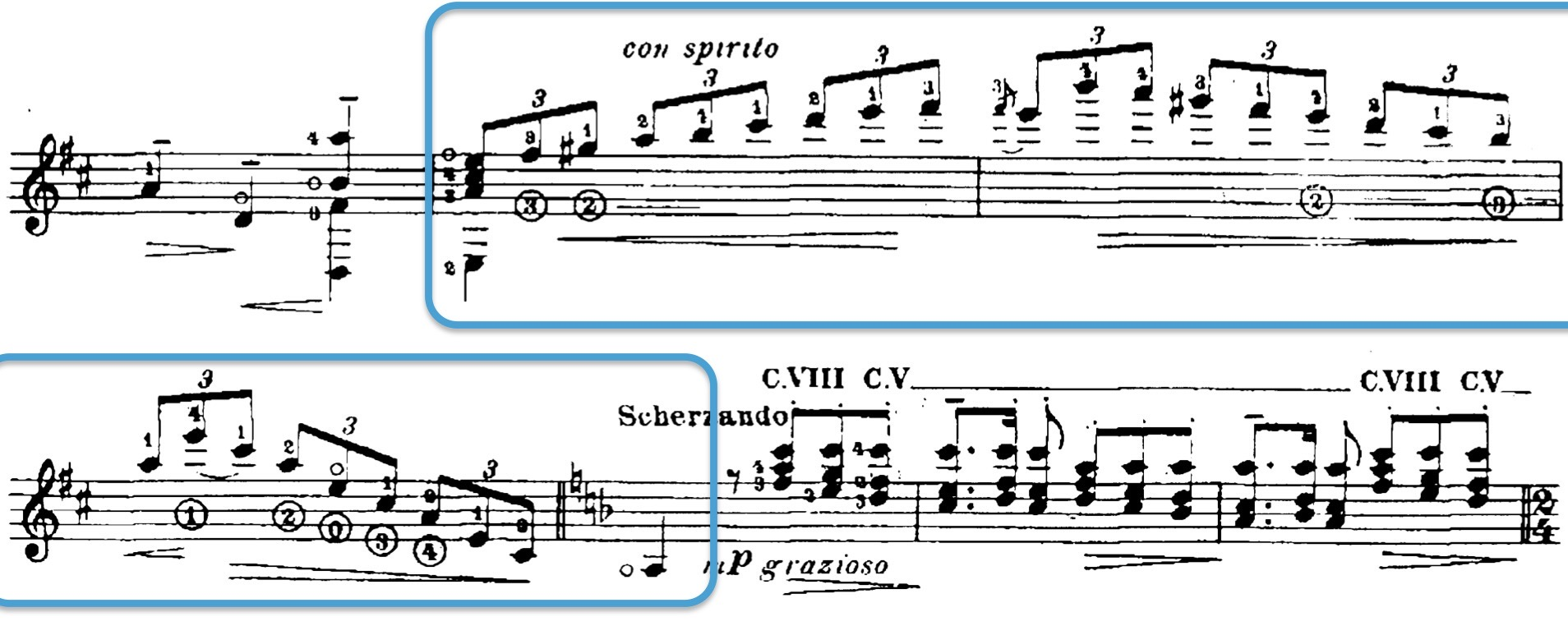


-B. 63: In the first pulse of this bar, Tedesco statically holds the lower voices without the upward and downward movement that is so characteristic of the piece. In the preceding and following bars he does so, so I deduce that this is a punctual erratum. It also makes musical sense to keep the flourish.
-B. 64: The last “C” of this measure, which belongs to the scale, is held up by the previous sharp. In my opinion, and taking into account the melodic development of the scale, also by playing, it makes more sense for it to be natural. Segovia also includes it in his version.
-B. 67-123: This section is arguably the most confusing of the whole piece. Castelnuovo writes this entire part with numerous measures that are very difficult to play, sometimes even impossible. The difficulty of these unguitaristic sections is compounded by the composer’s very fast tempo indication “Vivace e rítmico”, where the guitarist mentions its impossibility. Segovia fills these sheets with corrections and annotations in which he proposes different alternatives to the composer, creating a certain disorder in the source.
For this reason, I have decided to focus throughout this section on the Segovia´s edition in order to obtain a more coherent, homogeneous, guitaristic result, and one that makes it possible to perform it with the speed and character desired by the composer.
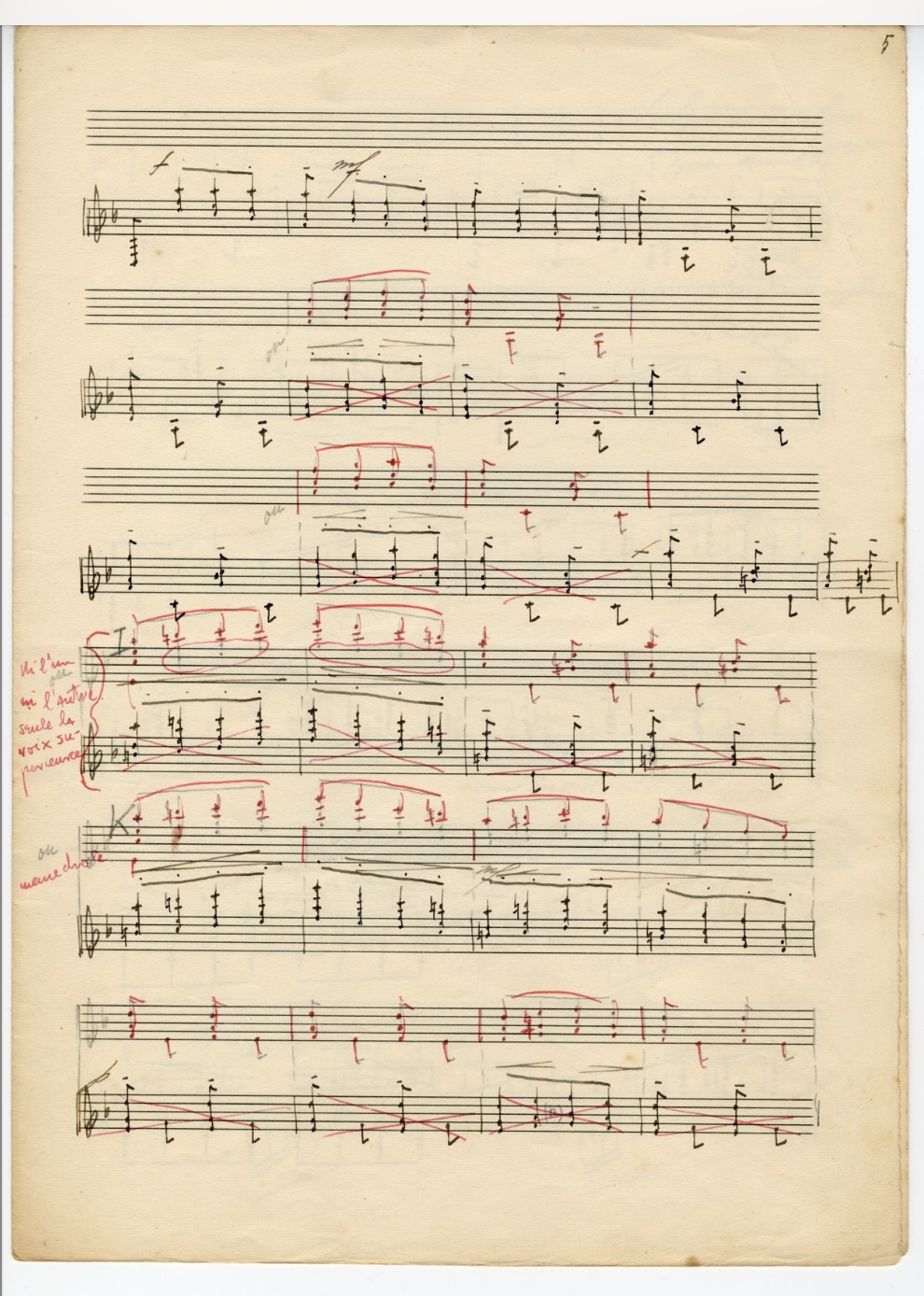
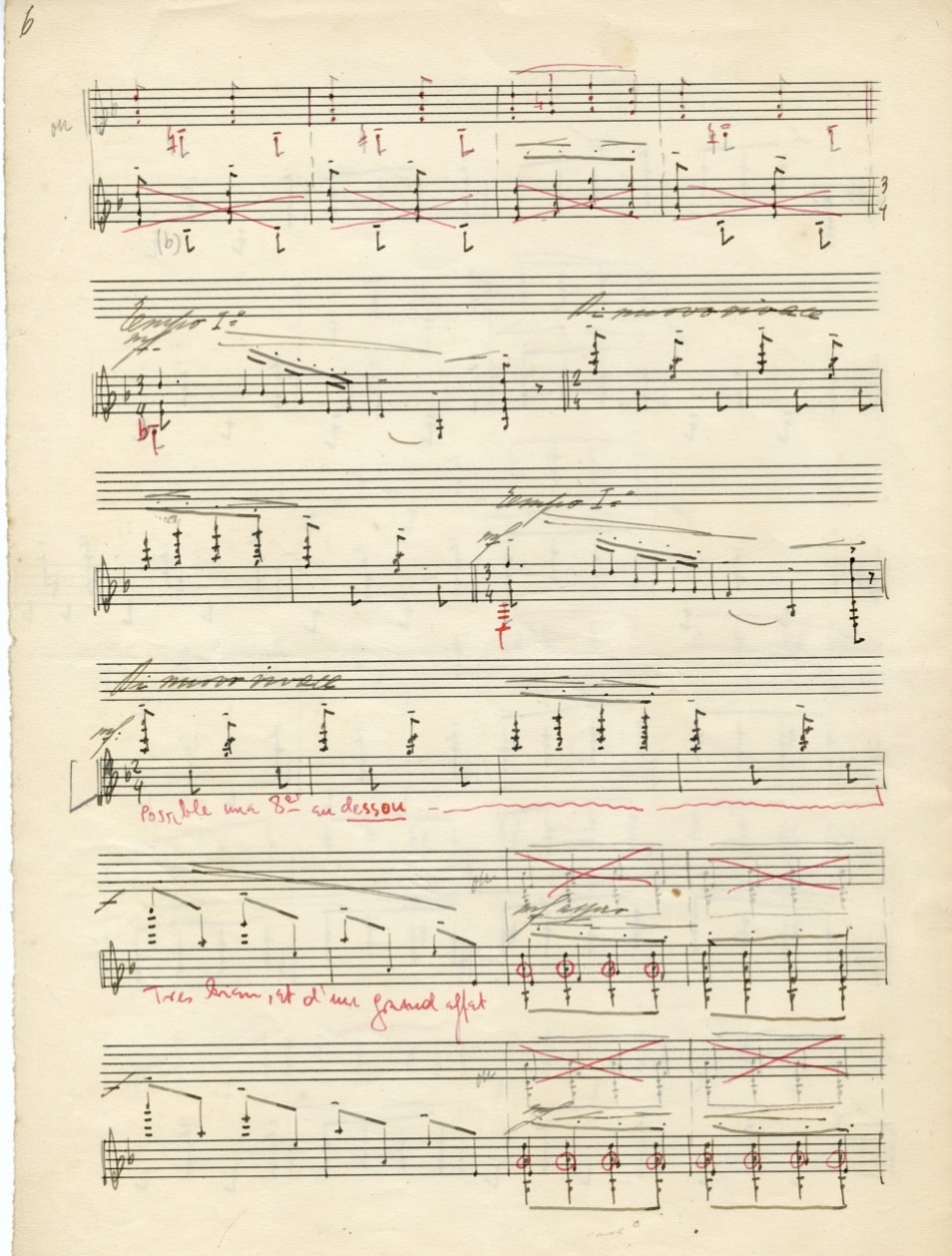

-B. 123-135 / 146-154: In these two sections I would like to talk about my interpretation. The composer writes in them the melody and the accompaniment articulated. Moreover, Segovia in his version keeps these staccatos. The character of these sections is Più calmo: Andantino grazioso (quasi Minuetto). Taking these indications into account, it makes sense that the whole part is played articulated. However, and only from my point of view, I like to play it more legato so that this central section contrasts with the Vivace e ritmico section that precedes it (a very percussive, articulated and powerful part). In this way I like to keep the mellowness and calmness that I personally feel this part conveys. I play everything Tedesco wrote.
In the videos I have decided to play the composer’s articulated version and Segovia’s version (with their respective changes, although I do not take them into account in my final version) as I prefer to play it: more legato. These changes are also explained in the following points.
Clips of bars 123-135
Tedesco´s Manuscript:
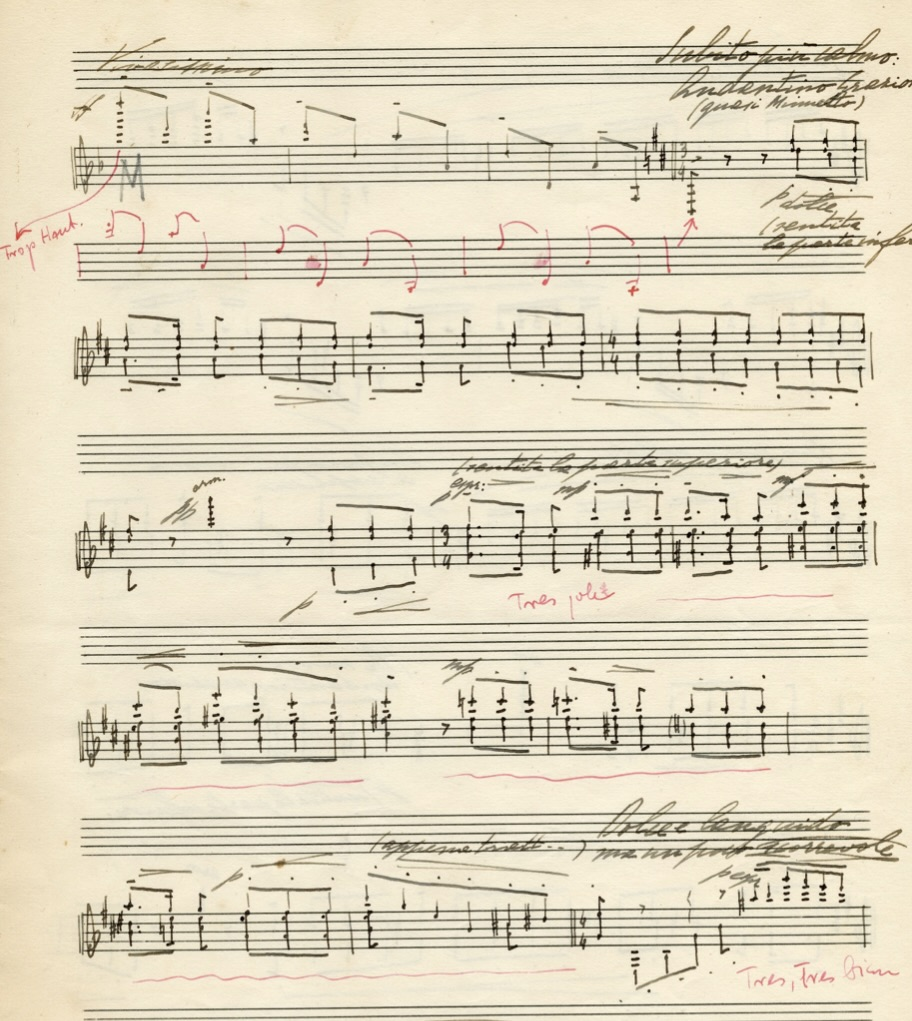
Segovia´s Version:
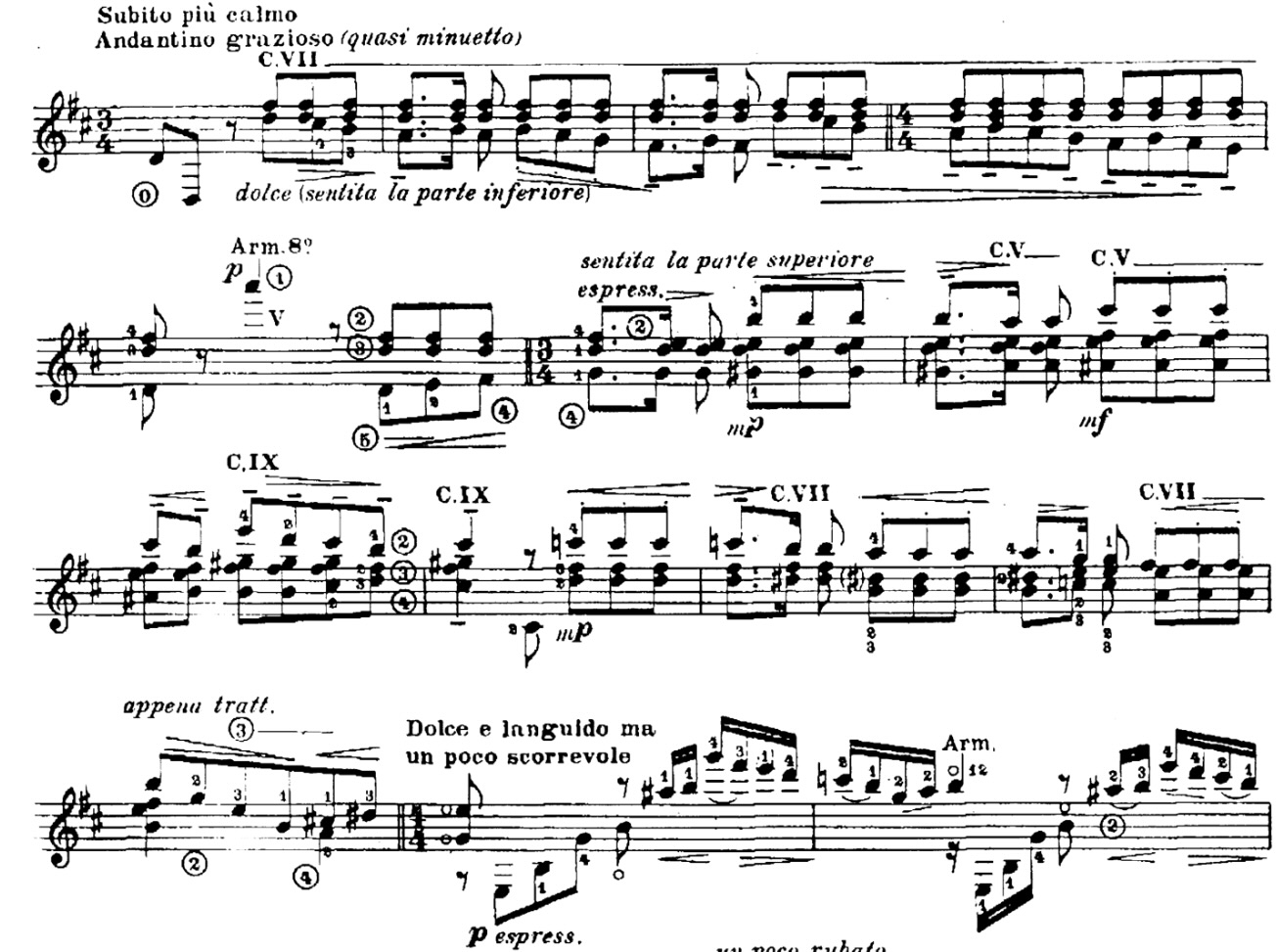
Clips of bars 146-154
Tedesco´s Manuscript:
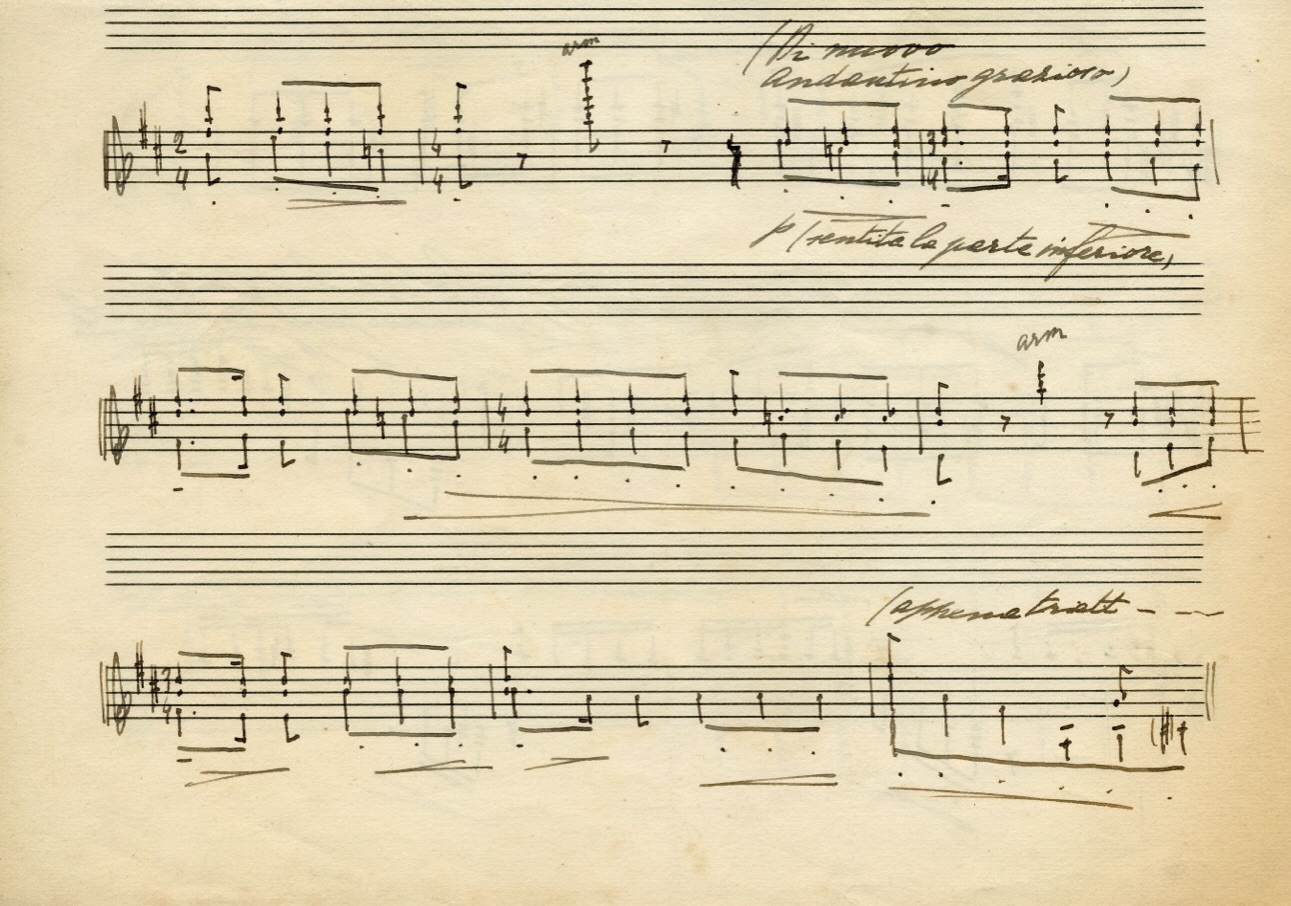
Segovia´s Version:
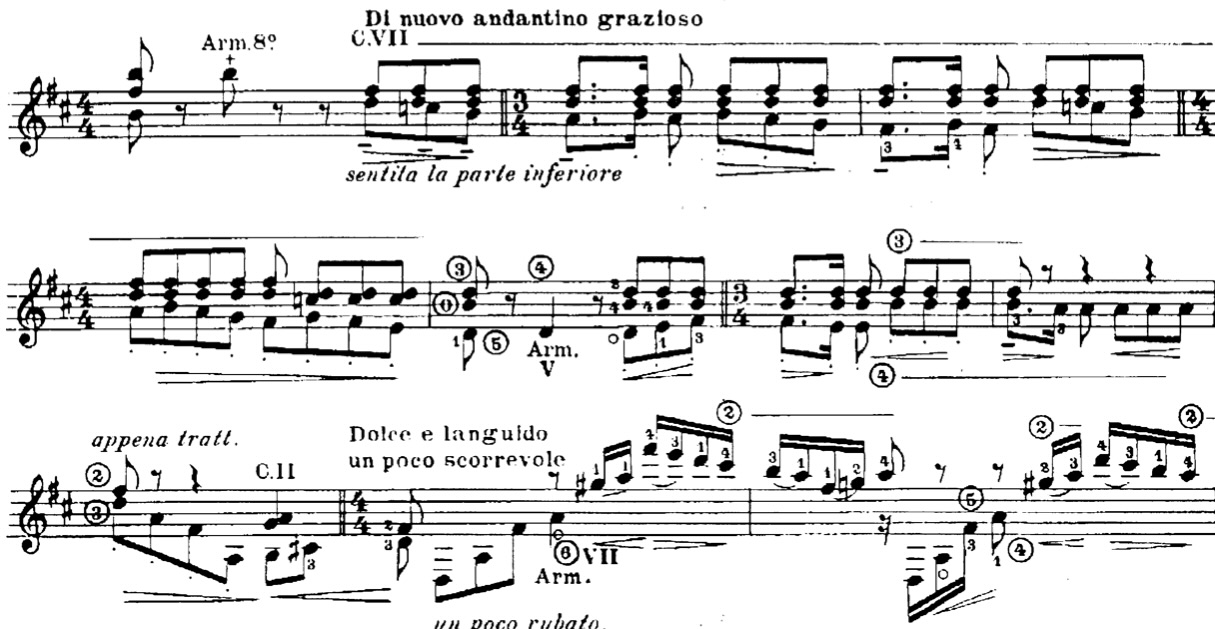
-B. 127, 146, 150: The harmonics of these measures are eliminated by Segovia for no apparent reason, since in the manuscript he does not even indicate it. I keep them in my score.
-B. 135-165: In all this central section I keep what the composer has written. Segovia makes several unnecessary changes, such as for example the “A” -which he plays as a harmonic- in the third pulse of measures 154 and 158 or the position of the notes of the arpeggio in measure 159.
-B. 166-167: I have taken the descending scale of these measures from the guitarist’s edition because the first bass of the tremolo is a D and if I had kept the one proposed by Castelnuovo it would be incomplete and without any musical sense. This scale acts as a link between the previous section and the tremolo section, so I think it has to take care not only of where we come from but also where we are going.
-B. 168: The composer decides to use a four-four time signature to write the tremolo. In this way, the eighth notes of the bass need a rest -of the same value- between one and the other to complete the bar. I think that it is more correct to use a two-four time signature with the tremolo written in demisemiquavers and thus also provide visual clarity. Tedesco does not write a specific speed indication, but he does write a character pattern, so the change of time signature does not affect the speed. In the same way, Segovia writes this part like this.
-B. 168-182: Castelnuovo writes in all this first part of the tremolo a G in all the first pulses. However, Segovia, realizing the awkward left hand postures and the emptiness sound of this section, writes a D. This decision was taken after practice and experimentation of the two options. Both can actually be played, but the result is more effective keeping the D bass, as the left hand positions are more comfortable and the sonority of the guitar is greater. In my opinion, this is much more appropriate. From my point of view it is much more coherent to keep this change made by the guitarist so that the tremolo has a resonant base and to avoid the guitar being muffled in a part as expressive as this one.
Clips of bars 166-183
Tedesco´s Manuscript:

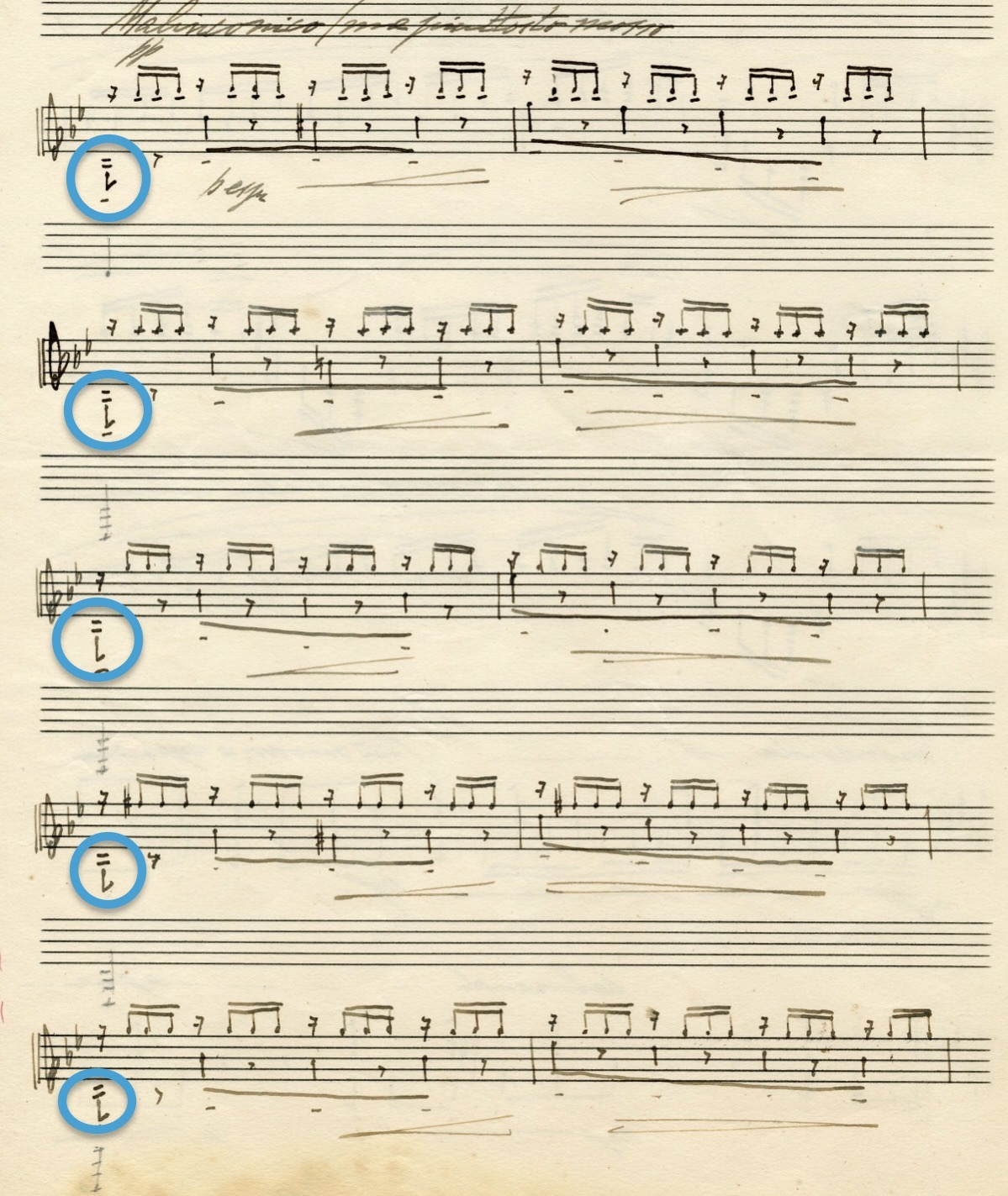
Segovia´s Version:

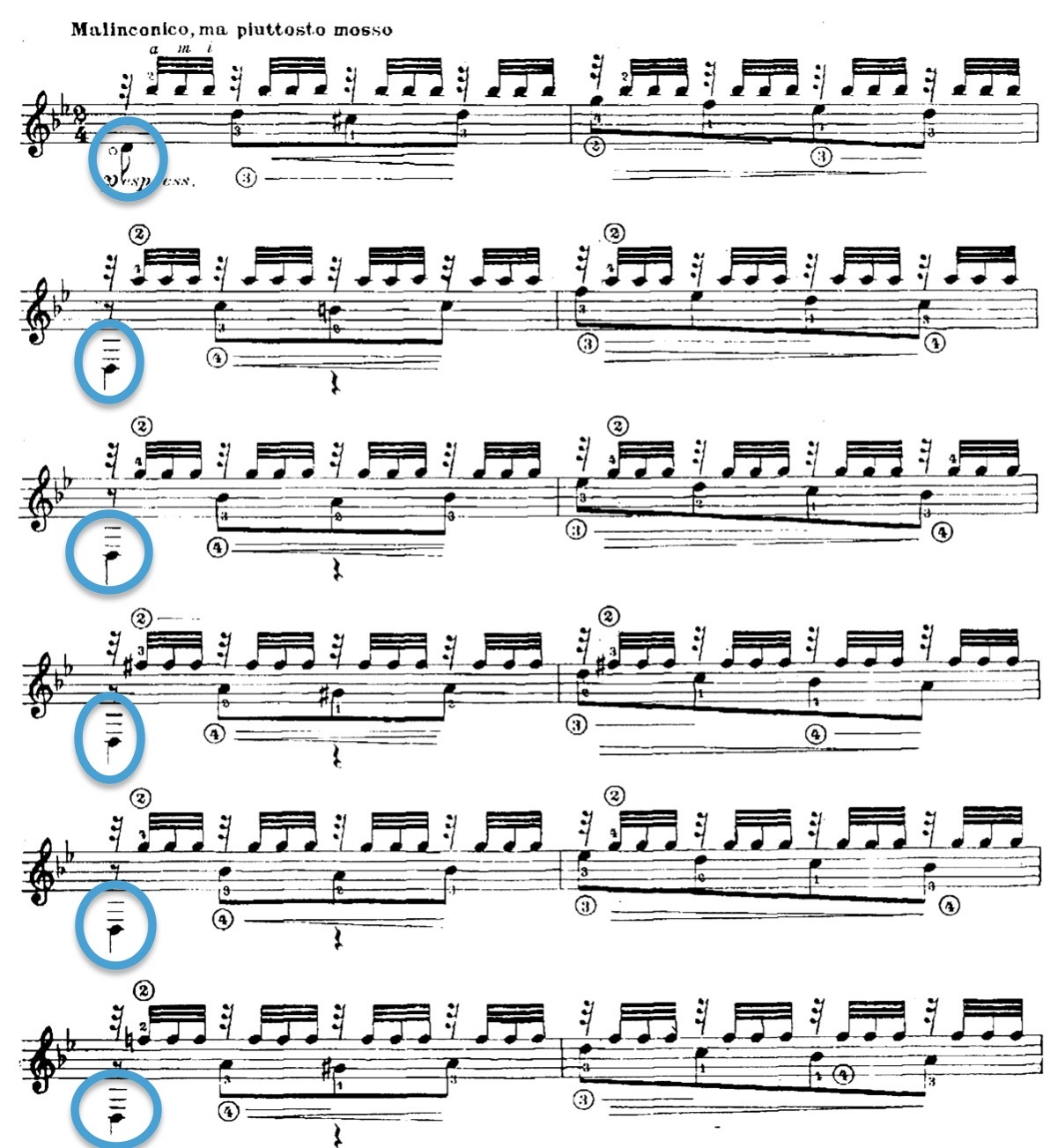
-B. 192-235: Throughout this part Segovia proposes multiple interpretative changes and suggestions to the composer in order to exploit the “virtuosic” resources of the guitar and impose his stylistic preferences. After practicing both options, I realised there is nothing in Tedesco’s writing that cannot be played, so I have decided to faithfully maintain his original idea which, in my opinion, enjoys great musical quality without needing a single change.
-B. 221: In this bar I have chosen the option proposed by Segovia. The first three chords written by Castelnuovo can be played. However, in the last one you have to remove notes and it is unbalanced if you play all the notes of the third one.
-B. 236-260: These bars comprise the Coda -Alla Marccia- section, completely eliminated by the guitarist in his version. I have, of course, kept it in my edition.
-B. 253-259: The composer’s writing is almost impossible, so I have decided to octave the bass melody for possible performance.
Clips of bars 236-264: (I play four bars longer than the coda length for the musical context).
Tedesco´s Manuscript:

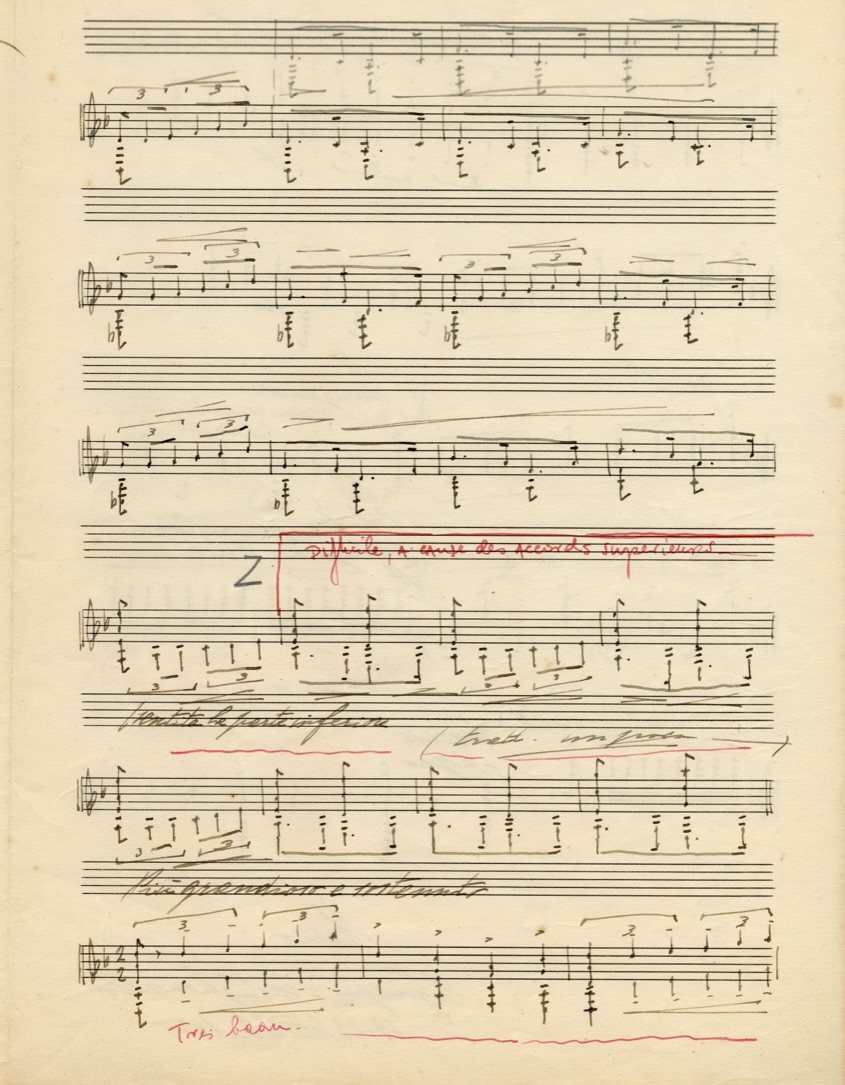
-B. 276-278: In these two bars Segovia asks the composer if he can be more specific in the theme he chooses for the composer’s quote to Concerto for violin no. 2 in B minor, op. 7, La campanella: III. Rondo by Paganini. In Segovia’s edition there are 7 bars that the guitarist wrote based on this movement according to his own taste and criteria. In this way, I have preferred to keep what the composer wrote.
Clips of bars 272-end
Tedesco´s Manuscript:
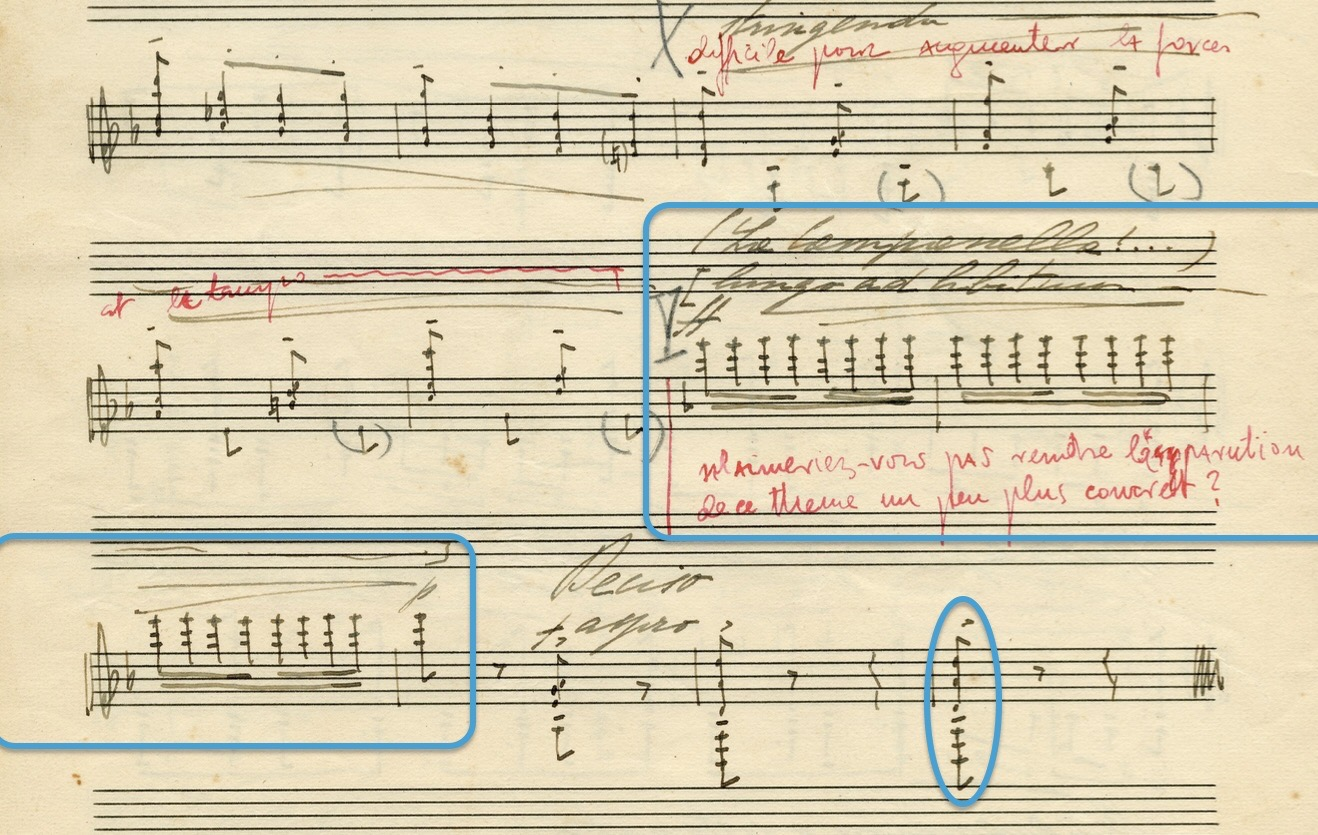
Segovia´s version:

-B. 281: The last chord of the piece, of course, also differs between the different scores. The option offered by Segovia consists in octaving the chord. It is a very typical resource that we can observe in many works for guitar and it gives a more romantic feel to the endings. However, I like Tedesco’s option better. He keeps the same chord twice and I believe it is a more rotund and powerful ending for this piece. That’s the way I end the performance.
2.6-SCORE OF MY CRITICAL EDITION
3.-CONCLUSIONS
As I describe in the first point of this work, choosing the Capriccio diabolico as a piece for my last year of master has been my most important motivation for the elaboration of this critical edition. All this year I have been working on it in order to write an effective and useful critical edition and to be able to play it successfully in my recital.
My aims were none other than to transcribe what Castelnuovo-Tedesco composed, using the manuscript as my primary source and taking into account, Segovia’s corrections. Before having the research carried out, and especially before studying this piece by myself, I was more reticent about Segovia’s decisions. As my study of it progressed, I realized that many of these changes, even though it was possible to play what the composer had written, were justified by something as substantial as the musical result. Many passages of the original score, when played, did not work because of speed, awkwardness of positions - not for lack of study - or empty and muffled sonority.
I think it is necessary to mention that my ‘prejudice’ at the beginning of this research, considering the manuscript as the most reliable, authoritative and complete source, has matured as the work has progressed. It is true, and I stress once again, that the guitarist eliminated passages and modified musical aspects as he liked and without being necessary on many occasions, but on the other hand, many of them are for purely guitaristic and functional reasons. The study of the work during the course -by playing-, is what has given me the necessary sieve to differentiate the reasons and decide the correct one.
Although in this type of work there is no absolute truth or indisputable answer, I would dare to say that the final result of my edition is duly justified; and under a previous and deep study -theoretical and practical- and a not simple dilemma, I offer to anyone who wants to approach this precious work, an artistic and well-founded performer’s edition.
4.-BIBLIOGRAPHY
4.1-SCORES
CASTELNUOVO-TEDESCO, Mario. Capriccio diabolico [Score]: (omaggio a Paganini): per chitarra [Original manuscript non published]. Castiglioncello: Italy, 1935. The manuscript remained in the custody of the Segovia Foundation in Linares, Jaén.
CASTELNUOVO-TEDESCO, Mario. Capriccio diabólico [Score]: (omaggio a Paganini): per chitarra / Mario Castelnuovo-Tedesco; [revisione e diteggiatura di] Andrés Segovia. Milano: Ricordi, 1973.
CASTELNUOVO-TEDESCO, Mario. Capriccio diabolico, Tarantella [Score]. per chitarra / Mario Castelnuovo-Tedesco, Nuova edizione fondata sui manoscritti originali. [A cura di] Angelo Gilardino e Luigi Biscaldi. Milano: Ricordi, 2006.
4.2-RECORDINGS
SEGOVIA, Andrés. An evening with Andrés Segovia. [Grabación sonora]. New York: Decca, 1954. Recorded compilation of works by various composers, including Castelnuovo-Tedesco, published with reference number DL 9733 in the “Gold Label” collection.
4.3-BOOKS
CASTELNUOVO-TEDESCO, Mario. Una vita di musica. Autobiography and Catalogue of his work. Ed. A cura de James Wesby; introduzione di Milla De Santis. Firenze, Italia: Edizioni Cadmo, 2005.
OTERO, Corazón. Mario Castelnuovo-Tedesco. Su vida y su obra para guitarra. Ediciones musicales Yolotl, México, 1987.
PERRICONE, Eloisa y SEBASTIANI, Adriano. Segovia e il suo repertorio. Graphos, Genova, 2002.PONSILLO, Cinzia. Musica: espressione di vita, pensiero estetico di Mario Castelnuovo- Tedesco, analisi e catalogo delle opere per chitarra, carteggio. Latina, Pair 2000, 1996.
4.4-RESEARCH WORKS
SOMOZA, Javier. Hacia una metodología para la edición del repertorio guitarrístico de Entreguerras. Trabajo de investigación (D.E.A.) Programa de Doctorado: “La Música en España e Hispanoamérica. Métodos y técnicas de investigación”. Universidad Complutense de Madrid. Facultad de Geografía e Historia. Departamento de Musicología, 2011.
4.5-DIGITAL BIBLIOGRAPHY
INNOCENTIS, Antonio de (intérprete). “Castelnuovo-Tedesco y la guitarra”. Programa de mano del 3er concierto del Ciclo del Sábado de la Fundación Juan March en abril de 1995 (sábado, 22.04.1995, 12 h.; Salón de Actos de la Fundación Juan March de Madrid): Fundación Juan March, 1995, accesible en https://www.march.es/actos/11375/, .
RUIZA, M., FERNÁNDEZ, T. y TAMARO, E. “Biografía de Mario Castelnuovo-Tedesco” [online]. En Biografías y vidas. La enciclopedia biográfica en línea. Barcelona, España: 2004. Accesible at https://www.biografiasyvidas.com/biografia/c/castelnuovo_tedesco.htm>.
WADE, Graham. “La relevancia de Mario Castelnuovo-Tedesco”, Repertorio de guitarra, Conservatorio de Música de Bahía Blanca, <https://hernanmouro.org/repertorio/repertorio-ii/1- modernismo/obras-para-segovia/castelnuovo-tedesco-mario/>.
4.6-DATABASES AND LIBRARY CATALOGUES CONSULTED
Database of Iberolibro: http://www.iberlibro.com
National Library of Spain: http://catalogo.bne.es/uhtbin/webcat
ANNEXES
-COMPOSER’S MANUSCRIPT
-EDITION BY ANDRÉS SEGOVIA
-EDITION BY ANGELO GILARDINO AND LUIGI BISCALDI
-
INOCENTIS, Antonio de (performer). Castelnuovo Tedesco y la guitarra. Programme of the III concert of the Fundación Juan March’s Ciclo de Sábados in April 1995 (Saturday, 22.04.1995, 12p.m.), accessible at https://www.march.es/actos/11375/. This section is based on a free translation by the author of this work. ↩︎
-
RUIZA, M., Fernández, T. y Tamaro, E. Biography of de Andrés Segovia. From Biografías y Vidas. The online biographical encyclopaedia. Barcelona, España . <https://www.biografiasyvidas.com/biografia/s /segovia.htm>. This section is based on a free translation by the author of this work. ↩︎
-
This section is based on a free translation by the author of this work from the Preface by Angelo Gilardino. CASTELNUOVO-TEDESCO, Mario. Preface of Capriccio diabolico, Tarantella per chitarra / Mario Castelnuovo- Tedesco, Nuova edizione fondata sui manoscritti originali. [A cura di] Angelo Gilardino e Luigi Biscaldi. Milano: Ricordi, 2006, p. 5-7. ↩︎
-
Since 2007 Ricordi is part of Universal Music Publishing Classical (UMPC), the European leader in classical music publishing. Other members of the publishing group are Editions Durand-Salabert-Eschig (Paris) and Editio Musica Budapest. ↩︎
-
This paragraph is based on a free translation by the author of this research, of Angelo Gilardino’s Preface. Castelnuovo-Tedesco, Mario. Preface of Capriccio diabolico, Tarantella per chitarra / Mario Castelnuovo- Tedesco, Nuova edizione fondata sui manoscritti originali. [A cura di] Angelo Gilardino e Luigi Biscaldi. Milano: Ricordi, 2006, p. 6. ↩︎
-
OTERO, Corazón. Mario Castelnuovo-Tedesco. Su vida y su obra para guitarra. Monterrey, México: Ediciones Musicales Yolotl, 1987, p. 114. ↩︎
-
OTERO, Corazón. Mario Castelnuovo-Tedesco. Su vida y su obra para guitarra. Monterrey, México: Ediciones Musicales Yolotl, 1987, p. 114. This paragraph is based on a free translation by the author of this research. ↩︎
-
OTERO, Corazón. Mario Castelnuovo-Tedesco. Su vida y su obra para guitarra. Monterrey, México: Ediciones Musicales Yolotl, 1987, p. 132. ↩︎
-
OTERO, Corazón. Mario Castelnuovo-Tedesco. Su vida y su obra para guitarra. Monterrey, México: Ediciones Musicales Yolotl, 1987, p. 132. This paragraph is based on a free translation by the author of this research. ↩︎
-
SEGOVIA, Andrés. An evening with Andrés Segovia. [Sound recording.] New York: Decca, 1954. Recorded compilation of works by various composers, including Castelnuovo-Tedesco, published with reference number DL 9733 in the “Gold Label” collection. ↩︎